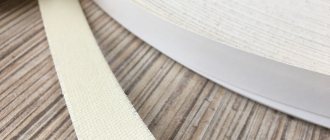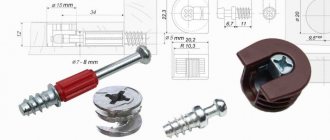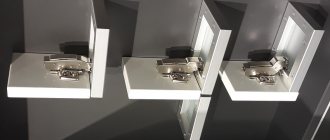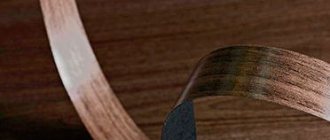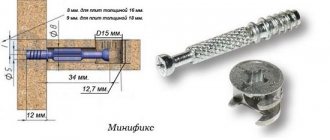Varieties of four-hinged furniture hinges for cabinets
The list of functional capabilities of furniture hinges is very large; they can be installed on cabinets made of various materials and of different, non-standard designs. Conventionally, all furniture hinges for cabinets can be divided into the following types.
According to the position of the door relative to the side wall
Regarding how the facade will cover the sides of the cabinet, three types of furniture hinges can be distinguished.
| Overhead furniture hinges - the door completely covers the end of the side of the cabinet |
| Inset (internal) furniture hinges – the end of the cabinet body is completely open. |
| Semi-overlay furniture hinges - the end of the body at the place where the canopy is attached is half hidden by the facade. |
By type of façade and body material
Separately, we can distinguish another type of furniture hinges with installation on glass facades and with a frame made of metal profiles.
By installation method
There are three types of furniture hinges, depending on the design and installation features with subsequent adjustment. The differences are obvious at the junction of the hinge body and the strike plate.
| Slide-on - the hinge body is inserted with a slot to look like an installed strike plate and is fixed in the desired position. |
| Clip-on – the hinge body is inserted into the groove of the installed strike plate, fixed by pressing, and adjusted with a fastening screw. |
| Key-hole - the hinge body with a hole is placed on the installed striker and is inserted under it with a translational movement until it reaches a fixed position. |
By bowl diameter
Most four-hinge furniture hinges have a bowl with a diameter of 35 mm. There are so-called “mini-loops”, in a more compact design, with a bowl diameter of 22-25mm.
With different opening angles
| A more complex design of the furniture hinge body can provide a larger opening angle, up to 165-170 degrees versus the standard 90-105 degrees. These types of furniture hinges are called “transformers”. |
Also in everyday life you can find the names “crocodile” and “crab”.
Furniture hinges with closer
You can read more about furniture hinges for cabinets with closers here. The mechanism itself for smoothly “pulling” the facade into the closed state can be built into the mechanism or overhead. In the first case, you should immediately buy furniture hinges with a closer, in the second, you can purchase it separately and install it on existing hinges (if the manufacturer has provided such an upgrade option).
Furniture hinges for corner cabinets
The design of the cabinet box can be corner or end, with various features and non-standard solutions. Furniture hinges for corner cabinets allow you to equip the facade with almost any type of furniture with an angle increment of 5 degrees.
In some design cases, the installation of a hinge requires the provision of special strips to make the angle “correct”, close to 30, 45, 60, 90 or 170 degrees.
Let us highlight the main types of furniture hinges for corner and end cabinets in tabular form, including those that are used to open facades attached to false panels and to each other, “accordion-style”.
| Adit (straight) loop for false panels. |
| For corner kitchen cabinets with 45 degree fronts. |
| For a beveled (end) kitchen cabinet with a -45 degree front. |
| For corner cabinets with fronts at 30 degrees. |
| For a beveled (end) cabinet with a facade at -30 degrees. |
| Carousel hinge for L-shaped accordion cabinet door. |
Hinge installation angles
The installation angle is the angle between the door and the side wall of the furniture box when closed. Typically the installation angle is 90°. Standard angles in hinge production are 90 degrees, but there are plus 30° and plus 45°, as well as minus 30° and minus 40 degrees.
But when making furniture or assembly errors, it is necessary to correct the standard installation angle. For this purpose, adjustable and non-adjustable pads are used. Non-adjustable pads are made of plastic with minus or plus 5 degrees. By placing loops on the side wall under the striker plate, you can adjust the angle plus or minus; you can place two or even three such pads. But if you need to adjust to an angle that is not a multiple of 5, then this lining will no longer be suitable.
How to choose corner hinges
To select corner hinges for furniture doors, you need to determine:
- type of loop;
- required opening angle.
Types of loops
Corner hinges for furniture can be:
internal or inset, installed when the door front is located inside the cabinet;
Furniture hinge for the door located inside the cabinet
invoices. Such hinges are installed on the fronts, which in the open position completely cover the side of the cabinet body.
Furniture hinge for external cabinet door
All types of corner-type furniture hinges have a number of features:
allow adjustment in three main directions. To do this, special adjustment bolts are installed on each hinge, by rotating which you can align the cabinet door vertically, horizontally and set the optimal rebate size;
How to adjust hinges after installation
can be equipped with a built-in or separate closer, allowing the door to close smoothly. A hinge with a closer, thanks to the functions of the device, can last a longer period of time.
Furniture hinges, complemented by a built-in closer
The type of furniture hinge should be determined based on the location of the cabinet door and the availability of additional options.
Determining the opening angle
The standard opening angle for furniture hinges is considered to be 95º-110º. If it is necessary to increase or decrease the opening angle of the cabinet door, then the installation of corner furniture hinges is required.
Each corner loop is marked with the sign:
- plus if the opening angle exceeds the standard. For example, an angular hinge 45+ means that the door can be opened to 135º;
- minus if, with the hinge installed, the door opens at an angle of less than 90º. For example, a -45 hinge helps the door open 45º.
On sale you can find corner hinges in increments of 5º. If an opening angle not a multiple of 5º is required, then when installing the hinge, additional pads are installed that allow you to independently change the angle specified by the parameters.
Device for determining the angle of a furniture hinge
To determine which hinge is required to install corner cabinet doors, use a special scale called a Pythagorean protractor.
The principle of working with the scale is extremely simple:
- the flat part of the protractor is attached to the cabinet box on the side where the hinge is supposed to be installed;
- The scale on the tool will tell you at what angle you need to purchase the loop. In this case, the optimal angle value will be located level with the lower side part of the cabinet box.
How to install furniture hinges
The bowl deserves the most attention in the hinge design. From the picture it is clear that it should literally be inserted into the surface. To do this, you need a hole (roughly speaking, an unfinished, not through hole), and a very respectable diameter. It is impossible to make such a hole with a regular drill; you will have to use a special cutter with a standard diameter of 35 mm, but there are other 25-32 mm mounting holes.
Forstner drill with height adjustment
There are different types of drill cutters
The illustration shows two cutters, a standard one and a slightly modified one. It's useful to have both. It is better to start cutting a hole with a regular cutter, but then it will be best to change it to a modified one. The reason is that a standard cutter has a protruding tooth. Beginners may inadvertently drill a through hole with a cutter instead of a hole, and the tooth on the cutter greatly contributes to this.
The hinges must be installed so as to support the door securely and without distortion. Therefore, when attaching furniture hinges, it is important to mark the surfaces of the cabinet and door as accurately as possible, marking the places for cutting holes for hinge bowls and for screwing in self-tapping screws.
Overview of species
With the expansion of the range of available furniture products, hinges for its installation have also received a certain development. Universal non-mortise models can be installed without milling. They are focused on wood-based panel materials, which usually have a decorative coating - where removing part of the surface is a serious problem.
Hinges that do not require insertion are usually classified according to the type of design and purpose of the product.
By design
The structural features of furniture fittings are the main feature by which they are usually divided into categories. The most popular options for hinges that do not require insertion are worth considering in more detail.
Eight-joint cups. They are considered a universal option used when assembling furniture. They have a wide selection of standard sizes.
These are the main options for furniture hinges, which do not require additional insertion into the facade during installation.
But even home craftsmen who do not have special training can fix such elements on cabinet doors or their bodies.
By purpose
The classification of all existing hinges installed without insertion also takes into account the purpose of such products. Among them are the following.
Furniture hinges. With their help, framed and frameless facades and other swing elements are mounted, in which it is quite difficult to make a hole without damage.
Furniture hinges are the most compact of the options presented. Their recommended loads rarely exceed 20 kg.
Corner furniture hinges
Door hinges are the main element of furniture cabinets of any size and any purpose. They come in various types, differing from each other in design features and purpose.
The most popular are the four-joint ones because they are durable and last a long time. They are divided into two types: straight (with an angle of 90 degrees) and angular (all other non-standard angles). Corner furniture hinges are used in sets when assembling corner cabinets.
What are they?
Ombre loops come in overhead and inset cylindrical types. Overlays are installed on the ends of the sashes in cases where the facades are thin, and installation of mortise elements that are less noticeable on furniture is not possible. The cylindrical hinge is convenient because it can be hidden inside both the end part and the folding part of the product. The fittings are often coated with zinc, which reliably protects metal structures from corrosion, and they can also be made of zinc alloy.
The cylindrical loop has design features. It is a rotating device and cannot withstand heavy loads, so it is not used for large structures. However, the metal part will be hidden when the table is unfolded, which will provide an attractive appearance to the product. Cylindrical hinges can be used for different facades: chipboard, MDF, solid wood.
Product sizes may vary. It is designated by markings, for example, D12, D14, D16, D24. Quite often the option with a diameter of 14 mm is used, since this value is optimal for the thickness of the fabric from which the doors of folding tables are made.
Types of loops
All furniture hinges are semi-mechanical parts for opening and closing facades. Taking into account the purpose and installation method, they are divided into:
- internal
- semi-invoice
- invoices
- card
- piano
- inverse
- corner
- heel
- pendulum
- ombre
- gallery
- secretory
- mezzanine
Furniture fittings can also be made of different materials and differ in opening angle. There are many different mechanisms on the market, including those designed for furniture and interior doors. Having similarity in appearance and method of functioning, products can withstand different loads. Therefore, for interior doors, what is best can be suggested by the specialist who will carry out the installation.
Materials for sliding doors
The most popular materials for the manufacture of sliding door systems today are:
- Tree
- Fiberboard or MDF
- Glass
Tree
The traditional material for the manufacture of not only doors, but also furniture in general, is wood. At the same time, both the entire panel (s) of the sliding door system and the frame for combination with other materials can be made from wood:
- Glass
- Plastic
- Paper
- Textile
- Mirror
The easy flexibility of wood to process allows it to be used for interior decoration in almost any style. Want a charming country room? Use unplaned wooden boards! Do you like classic style interiors? Choose a wooden door leaf with strict shapes. Are you striving to create an interior in a shabby chic or art deco style? Give preference to carved wood with forged elements or inlay. Are you a supporter of the East? Use canvases with a wooden frame and rice paper inserts.
Fiberboard/MDF
Since wood is not the cheapest material, it can easily be replaced by materials such as fiberboard or MDF. In appearance, they are almost impossible to distinguish from natural wood, but the cost is an order of magnitude lower than that of similar products made from natural wood.
Glass
Glass sliding doors are an excellent option for creating an interior in minimalist, futuristic or hi-tech styles. Due to the property of glass to transmit light, glass interior sliding doors do not create a feeling of total enclosure of space. Moreover, by choosing the degree of color and opacity of the glass for the door leaf, you can select the degree of transparency (and, as a result, integration with the neighboring room) of the interior doors.
Types of furniture hinges
Nowadays, on store shelves, consumers encounter a wide range of products in this area. Mounts may vary in:
- structural features,
- installation method,
- intended purpose.
The fittings create a certain style. Thanks to it, the design level of any household item is determined.
By paying attention to such points, you can choose the most functional options that satisfy a specific request. Depending on the method of application to the base, the components have different names. One of the most important parts of the fittings are the hinges.
One of the most important parts of the fittings are the hinges.
Overhead and semi-invoice
One of the most common among specialists are overhead four-hinged structures. This option is used when the door completely covers the walls of the box on which it is installed. It is popular for installation on any furniture: kitchen, dressing room, office. The product makes it possible to completely close the cabinet by tightly pressing the movable front panels to the base.
The mechanism allows you to open the door 90 degrees. It also supports the sashes in the chosen position and prevents misalignment.
If the side of the niche is covered simultaneously by two door panels, semi-overlay parts are used. Their distinguishing feature is the bending of the base. Thanks to this feature, it is possible to obtain a small gap between the components of the facade placed on the same area.
Most often, this type of hinge is included in kitchen sets.
Inverse and piano
Inverse fastenings allow opening 180º, forming a single line with the side of the box. Such components are most often used to equip built-in spaces.
This option is used for bedside tables and cabinets. It allows you to securely fasten the side part.
The piano mechanism is an obsolete type of product. It is very simple and understandable even to an inexperienced master, but still cannot boast of reliability. The design consists of two identical metal strips connected by steel wire in the middle. Most often this type is found on samples from past years. But sometimes it is still used today, for example, in making a kitchen corner with folding seats.
This view is considered obsolete. That is why it is rarely used and included in modern designs.
Internal and corner
The internal structure is taken when it is necessary to place doors inside a niche. That is, the sash does not overlap the ends of the walls, but is located directly between them inside.
The hinge is often included in pencil cases and cabinets that have heavy doors.
In most cases, it is necessary to provide a rectangular opening. But sometimes you need to attach the facade at an angle that differs from the standard by several degrees in one direction or another. In this case, special fasteners are used, which are marked accordingly:
- “plus” if an opening with a value above 110º is expected;
- “minus” when the opening level is below 90º.
Most often, such hinges are purchased for corner cabinets.
The hinge accepts any angle and provides the system with the necessary strength. It is also possible to supplement the system with closers.
Note! Products in this group on the market have a pitch of 5º. If the obtained value is not a multiple of this indicator, then additional overlays are used. These devices allow you to set the correct parameters yourself
These devices allow you to set the correct parameters yourself.
Card loops
Representatives of this group are in many ways reminiscent of their piano counterparts. It also consists of two metal plates that are connected by one hinge. Most often, this thing is used in furniture design to give things an antique effect. Card elements are often made in the form of various figures with wavy, rounded or pointed edges.
With its help, retro-style interior items are most often added.
Gallery and card shops
The adit components allow you to attach the sash not to the sidewall, but to the blank wall of the cabinet located in front. Often this type of accessory is also called “blind” because they attach the door to the adjacent false panel.
If the fittings are of high quality, then with its help it will be possible to secure a door of any weight and size.
Card auxiliary ones are used to attach folding elements. This part is installed on the cabinet from the ends, which makes it possible to move the sash 180º.
The holder can also be used as part of folding parts of furniture.
How to choose a milling fixture
Experts note that it helps speed up the work process several times. Moreover, the prepared niche turns out much smoother and neater than when using hand tools. When reading reviews, you need to immediately find out whether both of these parameters are provided or not
There are different types of locking devices, but they do not replace each other - so this point is worth paying special attention to. Vertical, also known as submersible, the device allows you to select grooves of arbitrary depth
At home, it is better to use a specialized router. At the same time, it does not require particularly high power; on the contrary, it will only unjustifiably increase the weight of the machine. But the option of adjusting the rotation speed of the cutter is very valuable for amateurs. It will help you complete all planned work more accurately.
Important: in a good machine, such a switch is placed in a safe place (even when working, you can stretch your hand there without fear) and allows you to regulate the speed of rotation smoothly, and not stepwise
Read also: Conductors for drilling holes in furniture
Another significant factor is how far the cutter can extend beyond the clamp. Usually this indicator is illustrated by numbers in the model name, and is expressed in millimeters. But it’s still worth reading the technical documentation to eliminate errors as much as possible. In addition, you need to look at whether it will be convenient to use the router.
This is determined by:
network cable length;
location of knobs and other controls;
list of functions performed.
Before purchasing, you should start the machine. If it is of high quality, the head should move completely freely. The slightest distortions and backlashes are unacceptable. The less noise the better. Also worth looking at:
Is there a wide view of the working surface?
is there any additional lighting provided?
Are there auxiliary attachments, holders, etc.
Installation stages
Installation of hinges on facades is carried out in 4 stages:
- first create markup;
- then make holes using a drill;
- then installation is carried out, as well as assembly of parts of the fittings;
- At the last stage, the doors are installed.
Stages of self-assembly of furniture, rules for deciphering drawings The most important and difficult stage is considered to be adjusting the position of the door relative to the furniture body. If the work is done incorrectly, the sash will quickly sag and the cabinet (or any other product) will fail.
Creating markup
To install furniture hinges correctly, you must initially make even markings that correspond to the parameters of the hardware plate. Otherwise, there will be problems with opening and closing doors. The marking of furniture hinges is done as follows:
- The distance between the canopies should be at least 50 cm. At this stage, the number of hinges required is determined.
- Start marking the center of the canopy holes. At the same time, they retreat from the edge of the door by 2–2.5 cm.
- Marks are applied taking into account the width of the door. At the intersection points, holes are made with self-tapping screws. At this stage it is worth using a template for marking furniture hinges.
Despite the fact that templates for furniture hinges are made of durable materials, they must be handled very carefully. It is strictly forbidden to drill through them, otherwise the service life will be reduced. To determine the number of loops needed, it is worth studying the recommendations presented in the table.
| Door weight, kg | Facade height, mm | Recommended number of loops |
| 4-5 | up to 500 | 2 |
| 6-9 | 500-1000 | 2 |
| 10-13 | 1000-1500 | 3 |
| 14-18 | 1500-2000 | 4 |
| 19-22 | 2000-2500 | 5 |
Hole preparation
The next step will be preparing the holes. To make the notches correctly, you need to accurately follow the markings already made. To carry out this operation, a drill with a special drill and a milling cutter are used. The holes are made like this:
- First you need to lay the door on a flat surface.
- Fix a cutter for furniture hinges of a suitable diameter in a drill. The depth of the hole should not exceed 1.25 cm.
- During the drilling process, the drill must be positioned strictly perpendicular to the surface of the door.
- During the process of forming the hole, you need to carefully ensure that the cutter or drill does not drill through the door.
Nuances of making furniture drawings, review of useful programs
When the main holes for the screws are ready, you can move on to the next stage. Inserting canopies in accordance with the markings and formed recesses is much easier and of better quality.
Hinge Attachment
The hinges are attached in the following sequence:
- The part of the loop that will be directly attached to the facade is placed in the bowl.
- The hinges are carefully positioned in the recesses to ensure optimal placement.
- Using a construction angle and a level, achieve an even position of the loop in the cup.
- If you need to correct the hole to lay the canopy evenly under the level, use a furniture cutter to install the hinges.
- Using a screwdriver, screw the screws into the holes on the hinge itself.
After fixing the screws, you need to check the strength of the canopy. It is recommended to try to loosen the hinge in the cup and move it relative to the surface of the facade. If no changes are observed, then the fittings are secured well.
Hanging the door
The most difficult stage in this work is the installation of the door. To simplify the task, if possible, it is worth laying the furniture body so that the doors are attached to the hinges in a horizontal position. Algorithm for installing doors:
- In the inside of the furniture body it is necessary to make the same markings as on the door. To install the hinges, you also need a furniture bit.
- Next, secure the platform to secure the canopy using self-tapping screws.
- Connect the two parts of the canopy.
- Finally, adjust the position of the fittings relative to the door and furniture body. This can be done using a screwdriver and a level.
Making upholstered furniture with your own hands, tips for beginners
Hanging the door is not the final stage of work. Even after the initial adjustment, additional measures must be taken to align the position of all components.
Loops for thick sides
When designing furniture to order, you have to adapt to the “wants” of customers, who, in turn, often turn out to be not entirely technically literate. And requests can sometimes be very strange. I had to design a cabinet with sides made of 25 mm chipboard, a so-so cabinet, medium in size, simple in configuration. But the expensive one is just terrible. The customer wanted MDF facades, such that he had to order them far away and wait more than a month. The cabinet, of course, was sawed and sent to the customer: they say, the facades will come, we’ll come and hang them. My problem is that I didn’t take into account that a simple loop, and one with a thick sidewall, won’t give a complete overlap, as the customer wants! The facades have arrived, how to plant them? Dripping with cold sweat, I began looking for an answer on forums and blogs.
Option one is to use loops with a cup with a diameter of 45 mm for the thick sidewall. Everything seems simple, the additive is clear, the loop itself has been worked out since time immemorial. But the problem is that it is catastrophically difficult to find in stock. Well, not a running size! Everyone is used to 35 mm and they don’t need another. Waiting another month for it to be delivered to order is also not an option. Among other things, also look for a cutter for them, something to attach the sidewalls with?
Option two loomed on the horizon after communicating with the Hettich manager. Who sold us a set of excellent hinges, swearing that everything would fit as it should. The hinges were brought to the workshop and installed on an improvised mock-up made of a thick sidewall and facade, but no matter how hard we worked, we were unable to achieve an overlap of more than 20mm! It is unknown where to get another 5mm - thanks, kind manager. The complete set in the photo below is still lying around in the workshop.
Option three is purely hardcore - we hang a regular loop, but in reverse: we place the cup on the side, and the counter on the front. With some effort in choosing filler sizes it works, but who would agree to this, especially since the customer already has the cabinet?
Option four is the saving one. The Blum Clip top 155 degree loop is found everywhere in any self-respecting store that sells accessories. Other manufacturers also have similar hinges, but the problem is that no one positions them as hinges for wide sidewalls. Yes, the range of problems solved by this hinge is much wider and it comes as a special-purpose hinge, but that’s why the managers selling it don’t know all its capabilities and to the question: “are there any hinges for thick sidewalls?” - They shrug their shoulders in bewilderment?
Well, okay, we found what we wanted! They began to recognize it by the additive. Well, here it is: don’t take managers at their word! Yes, they have a program compiled by blum engineers that easily calculates all this, but in the hands of the seller it is a terrible evil! They advised us to make the additive as much as 40 mm, the loop has a strange shape - why not? Does not work! Those. It also works with the adjustment turned all the way down, and it’s quite small for this loop, the overlap is 23mm! No matter how ice.
In general, the necessary additive was found by trial and error. And everything turned out to be much simpler! A regular loop with a 35mm cup is seated at 22mm, while the overlay is standard - 14mm plus or minus adjustment. We need an overlap of 25mm: 25-14-2=9mm. We add the resulting 9 mm to 22 mm of our standard additive and we get 31 mm with an adjustment of the order of plus or minus 4 mm.
Areas of use
The use of furniture hinges without mortise may be determined by the type of product design or the materials used. These can be thin doors in frames made of chipboard or plywood, or other options in which drilling holes is somewhat difficult. Special non-mortise hinges are produced for glass elements; you don’t even need to drill holes for them. For aluminum structures, fittings are often supplied immediately complete with the furniture profile.
The use of such fasteners is most in demand when assembling cabinet furniture, built-in and conventional, free-standing. Options without drilling are mounted like clamps, securing the blade in a kind of groove. They are in demand when assembling display cabinets with a large glazing area.
Four-hinge hinges
The most widespread in the production of cabinet products intended for the arrangement of any residential and domestic premises are four-hinged hinge structures, the advantages of which are:
- high strength of individual elements, ensuring reliable operation of the product as a whole;
- a large number of operation cycles, ensuring the operation of the product during its entire service life;
- Possibility of adjusting the door leaf in three planes.
The design of the four-hinged hinge includes:
- cup;
- shoulder;
- installation site;
- additional elements - an adjusting screw and a decorative flange.
As a rule, the cup is installed in a special recess milled in the door. In order to reduce the range of cutters (Fosner drills), most loop specimens have a cup with a diameter of 35.0 millimeters.
Cups with a smaller diameter (26.0 millimeters) have models designed for installation on door leaves that are small in weight and size, as well as on hinged glass doors, such as in sideboards. The lever arm is the body of the adjustment mechanism and is connected to the installation platform, fixed inside the furniture compartment, on its sidewall. Fastening of all elements of hinge fittings is carried out with self-tapping screws or using a screw confirmation.
Types of furniture hinges by design
There are many hinges and canopies used to attach a swing door to the frame of a cabinet or cabinet. Basically, in modern furniture production, four-hinged hinges are used, which allow the facade to be adjusted in three planes at once:
All of them consist of two interconnected parts - a bowl with an elbow and a counter plate. Often the strike plate is called a mounting or mounting plate. This article will focus specifically on four-hinged hinges.
Other types of furniture hinges can be combined into one large group as “bowlless” hinges.
First of all, these are piano hinges, card hinges, pin hinges, and heel hinges, known to everyone for fastening interior doors and facades in old furniture. They are rarely used in modern furniture. For example, piano, card and mortise hinges can be used to attach tabletops to the base, movable legs in book-tables. For ordinary cabinets, brass decorative hinges are used as additional decor.
Overhead hinges that do not require drilling of the facade. They come in handy when the thickness of the material chosen for the facade does not allow installing (embedding) a four-hinged hinge due to the depth of the bowl. The only drawback of such hinges is their rigid fastening, which does not allow adjustment in three planes, like four-hinge hinges.
Hinges for fastening specific facades. For example, prefabricated facades made of aluminum frames of different widths are installed on special hinges - you can purchase them together with the profile
Please note that just like regular four-hinged hinges, they can be overhead and internal, designed for corner cabinets of 45, 135, 180 degrees and facades covering the end of the case
Four-hinged furniture hinges and their types
The difference between these hinges is how the bowl is attached to the knee and the striker. There are three types of four-hinged hinges:
SlideOn K9.5 semi-overlay hinge 1078661
55.20 ₽
Slide-on - such loops are connected to each other with a special screw that has notches. The purpose of the notches is to prevent the elements from coming loose, even when the screw is loosened.
Clip-on - the connection of such loops occurs using a regular snap, without the use of a screw. This façade is easy to install without tools. All you need to do is pull the latch. This type of hinge is often called quick installation hinges.
Key-hole – the difference between these loops is the presence of holes, the shape of which resembles a keyhole. All fastening is done by passing the screw head through the hole.
90 degree hinges
A loop with an angle of 90 degrees is conditional. This is to indicate the markings and how wide the loop opens. But in fact, the door opening width is much larger, for example, not 90 degrees, but 100 degrees. In this case, loops are sometimes marked as a 100 degree loop. There is nothing wrong with this labeling.
Overhead loop Planet B02-00 (200 pcs/pack)
32.00 ₽
Overlay at 90 degrees - this loop differs from others in the bend of the shoulder, namely in that there is no bend. It is used when you need to completely close the side ends of the walls.
Half-overhead loop Planet V02-08 (200 pcs/pack)
32.00 ₽
Semi-overlay loop (90 degrees) - in such a loop the bending arm reaches an average value and is used quite rarely. They are mainly used for kitchen cabinets to secure the bottom doors. Such hinges can also be found in three-leaf wardrobes.
Insert loop Planet V02-17 (200 /pack)
32.00 ₽
Inset loop (90 degrees) – such a loop has a fairly large angle of bending of the shoulder. It is needed if an inset door is installed on the facade, which, when opened, will not extend beyond the body. This type is rarely used; it can be found in office furniture, the body of which is made of 22 mm chipboard.
180 degree hinges
Straight hinge - used if you need to attach a door to a facade that is parallel to it. Widely used in the manufacture of corner kitchens.
Hinge 165* Planet K29-00 (A38-00) with closer (50/pack)
246.00 ₽
165 degree carousel - this model can be recognized by the shape of the kneecap. It is this that ensures the door is fully deployed, almost up to 180 degrees. Such a loop can be of several options: overhead, semi-overlay and inset.
Types of corner hinges
Loop +30* BT404 (150 pcs/pack)*! PROMOTION!
23.00 ₽
30 degree corner hinge - this model presses the facade well; as a rule, such a hinge is placed at an angle of 90+30 degrees. It is used in sloping cabinets in the kitchen or dressing rooms.
Loop 45* Planet VT404-45* (200/pack)
42.00 ₽
45 degree corner hinge - such hinges are used in single and double door trapezoidal cabinets. The loop can be installed similarly to the previous option.
Loop +115* Planet BT404 d/skl. dv. 25*/90*(150 pcs/pack)
66.00 ₽
Angle loop 120-135 degrees - the loop is used when it is necessary to connect two facades to each other, but at an angle of 270 degrees.
According to the method of applying the sash to the body
- Insert loop Planet V02-17 (200 /pack)
32.00 ₽
Internal loop - at first glance, this loop looks like a regular overhead model, but it is used for other purposes. It is used when the furniture structure is made in such a way that the door is located in the body and it is simply impossible to install a regular hinge.
Therefore, the hinge is mounted inside the cabinet, and the design of the hinge has a strong bend so that the door opens easily.
Piano hinge L=1000 zinc (50 pcs/pack)
121.00 ₽
Piano Hinge - As the name suggests, the hinge was used for the lids of pianos. The model is a rarity and is practically not found on modern furniture. The only place where you can see a similar model is antique furniture.
Locking loop (right, left)
136.60 ₽
Mezzanine hinge - as the name implies, it is used on facades that open upward. These hinges are mainly used on chests of drawers and cabinets. In its design, it is similar to a regular loop, but it is based on a spring.
The secretory loop is very similar in mechanism to a piano loop. It consists of two plates connected by a hinge. This fastener is used for cabinet doors that open horizontally rather than vertically.
Such loops were very popular on secretaries - special compact cabinets in which papers were stored.
Installation of hinges
To install hinges, you do not need any special knowledge or skills. All you need is attention, compliance with the rules and recommendations.
During the installation process, you need to take into account the features of the process. For example: when you make markings, make sure that after installation the loops do not intersect with each other.
The final stage of installation is adjusting the fittings. This procedure requires care, because the functionality of the furniture will depend on this.
Actually, this is all the necessary information you need to know for selecting and installing furniture hinges.





